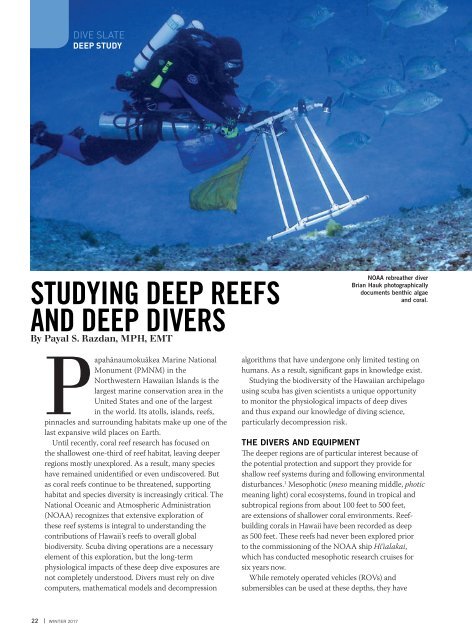AD 2017 Q1
Alert Diver is the dive industry’s leading publication. Featuring DAN’s core content of dive safety, research, education and medical information, each issue is a must-read reference, archived and shared by passionate scuba enthusiasts. In addition, Alert Diver showcases fascinating dive destinations and marine environmental topics through images from the world’s greatest underwater photographers and stories from the most experienced and eloquent dive journalists in the business.
Alert Diver is the dive industry’s leading publication. Featuring DAN’s core content of dive safety, research, education and medical information, each issue is a must-read reference, archived and shared by passionate scuba enthusiasts. In addition, Alert Diver showcases fascinating dive destinations and marine environmental topics through images from the world’s greatest underwater photographers and stories from the most experienced and eloquent dive journalists in the business.
You also want an ePaper? Increase the reach of your titles
YUMPU automatically turns print PDFs into web optimized ePapers that Google loves.
DIVE SLATE<br />
DEEP STUDY<br />
STUDYING DEEP REEFS<br />
AND DEEP DIVERS<br />
By Payal S. Razdan, MPH, EMT<br />
NOAA rebreather diver<br />
Brian Hauk photographically<br />
documents benthic algae<br />
and coral.<br />
Papahānaumokuākea Marine National<br />
Monument (PMNM) in the<br />
Northwestern Hawaiian Islands is the<br />
largest marine conservation area in the<br />
United States and one of the largest<br />
in the world. Its atolls, islands, reefs,<br />
pinnacles and surrounding habitats make up one of the<br />
last expansive wild places on Earth.<br />
Until recently, coral reef research has focused on<br />
the shallowest one-third of reef habitat, leaving deeper<br />
regions mostly unexplored. As a result, many species<br />
have remained unidentified or even undiscovered. But<br />
as coral reefs continue to be threatened, supporting<br />
habitat and species diversity is increasingly critical. The<br />
National Oceanic and Atmospheric Administration<br />
(NOAA) recognizes that extensive exploration of<br />
these reef systems is integral to understanding the<br />
contributions of Hawaii’s reefs to overall global<br />
biodiversity. Scuba diving operations are a necessary<br />
element of this exploration, but the long-term<br />
physiological impacts of these deep dive exposures are<br />
not completely understood. Divers must rely on dive<br />
computers, mathematical models and decompression<br />
algorithms that have undergone only limited testing on<br />
humans. As a result, significant gaps in knowledge exist.<br />
Studying the biodiversity of the Hawaiian archipelago<br />
using scuba has given scientists a unique opportunity<br />
to monitor the physiological impacts of deep dives<br />
and thus expand our knowledge of diving science,<br />
particularly decompression risk.<br />
THE DIVERS AND EQUIPMENT<br />
The deeper regions are of particular interest because of<br />
the potential protection and support they provide for<br />
shallow reef systems during and following environmental<br />
disturbances. 1 Mesophotic (meso meaning middle, photic<br />
meaning light) coral ecosystems, found in tropical and<br />
subtropical regions from about 100 feet to 500 feet,<br />
are extensions of shallower coral environments. Reefbuilding<br />
corals in Hawaii have been recorded as deep<br />
as 500 feet. These reefs had never been explored prior<br />
to the commissioning of the NOAA ship Hi’ialakai,<br />
which has conducted mesophotic research cruises for<br />
six years now.<br />
While remotely operated vehicles (ROVs) and<br />
submersibles can be used at these depths, they have<br />
22 | WINTER <strong>2017</strong>









